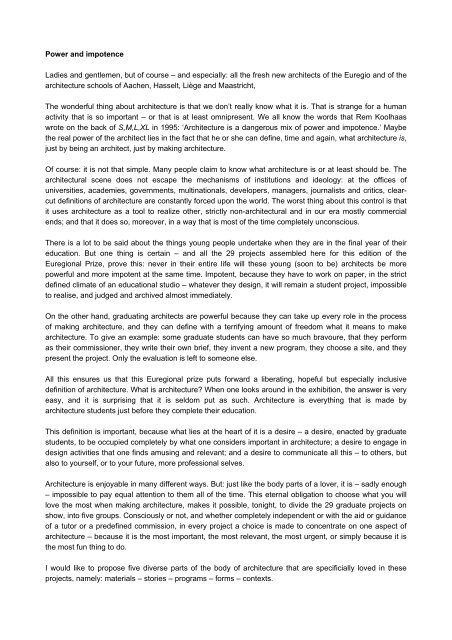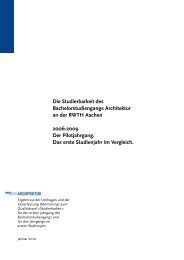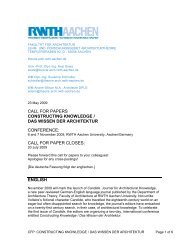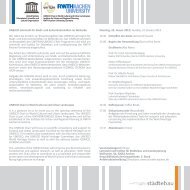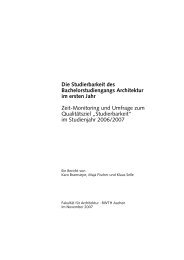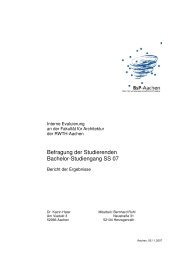Power and impotence Ladies and gentlemen, but of ... - RWTH Aachen
Power and impotence Ladies and gentlemen, but of ... - RWTH Aachen
Power and impotence Ladies and gentlemen, but of ... - RWTH Aachen
You also want an ePaper? Increase the reach of your titles
YUMPU automatically turns print PDFs into web optimized ePapers that Google loves.
<strong>Power</strong> <strong>and</strong> <strong>impotence</strong><br />
<strong>Ladies</strong> <strong>and</strong> <strong>gentlemen</strong>, <strong>but</strong> <strong>of</strong> course – <strong>and</strong> especially: all the fresh new architects <strong>of</strong> the Euregio <strong>and</strong> <strong>of</strong> the<br />
architecture schools <strong>of</strong> <strong>Aachen</strong>, Hasselt, Liège <strong>and</strong> Maastricht,<br />
The wonderful thing about architecture is that we don’t really know what it is. That is strange for a human<br />
activity that is so important – or that is at least omnipresent. We all know the words that Rem Koolhaas<br />
wrote on the back <strong>of</strong> S,M,L,XL in 1995: ‘Architecture is a dangerous mix <strong>of</strong> power <strong>and</strong> <strong>impotence</strong>.’ Maybe<br />
the real power <strong>of</strong> the architect lies in the fact that he or she can define, time <strong>and</strong> again, what architecture is,<br />
just by being an architect, just by making architecture.<br />
Of course: it is not that simple. Many people claim to know what architecture is or at least should be. The<br />
architectural scene does not escape the mechanisms <strong>of</strong> institutions <strong>and</strong> ideology: at the <strong>of</strong>fices <strong>of</strong><br />
universities, academies, governments, multinationals, developers, managers, journalists <strong>and</strong> critics, clearcut<br />
definitions <strong>of</strong> architecture are constantly forced upon the world. The worst thing about this control is that<br />
it uses architecture as a tool to realize other, strictly non-architectural <strong>and</strong> in our era mostly commercial<br />
ends; <strong>and</strong> that it does so, moreover, in a way that is most <strong>of</strong> the time completely unconscious.<br />
There is a lot to be said about the things young people undertake when they are in the final year <strong>of</strong> their<br />
education. But one thing is certain – <strong>and</strong> all the 29 projects assembled here for this edition <strong>of</strong> the<br />
Euregional Prize, prove this: never in their entire life will these young (soon to be) architects be more<br />
powerful <strong>and</strong> more impotent at the same time. Impotent, because they have to work on paper, in the strict<br />
defined climate <strong>of</strong> an educational studio – whatever they design, it will remain a student project, impossible<br />
to realise, <strong>and</strong> judged <strong>and</strong> archived almost immediately.<br />
On the other h<strong>and</strong>, graduating architects are powerful because they can take up every role in the process<br />
<strong>of</strong> making architecture, <strong>and</strong> they can define with a terrifying amount <strong>of</strong> freedom what it means to make<br />
architecture. To give an example: some graduate students can have so much bravoure, that they perform<br />
as their commissioner, they write their own brief, they invent a new program, they choose a site, <strong>and</strong> they<br />
present the project. Only the evaluation is left to someone else.<br />
All this ensures us that this Euregional prize puts forward a liberating, hopeful <strong>but</strong> especially inclusive<br />
definition <strong>of</strong> architecture. What is architecture? When one looks around in the exhibition, the answer is very<br />
easy, <strong>and</strong> it is surprising that it is seldom put as such. Architecture is everything that is made by<br />
architecture students just before they complete their education.<br />
This definition is important, because what lies at the heart <strong>of</strong> it is a desire – a desire, enacted by graduate<br />
students, to be occupied completely by what one considers important in architecture; a desire to engage in<br />
design activities that one finds amusing <strong>and</strong> relevant; <strong>and</strong> a desire to communicate all this – to others, <strong>but</strong><br />
also to yourself, or to your future, more pr<strong>of</strong>essional selves.<br />
Architecture is enjoyable in many different ways. But: just like the body parts <strong>of</strong> a lover, it is – sadly enough<br />
– impossible to pay equal attention to them all <strong>of</strong> the time. This eternal obligation to choose what you will<br />
love the most when making architecture, makes it possible, tonight, to divide the 29 graduate projects on<br />
show, into five groups. Consciously or not, <strong>and</strong> whether completely independent or with the aid or guidance<br />
<strong>of</strong> a tutor or a predefined commission, in every project a choice is made to concentrate on one aspect <strong>of</strong><br />
architecture – because it is the most important, the most relevant, the most urgent, or simply because it is<br />
the most fun thing to do.<br />
I would like to propose five diverse parts <strong>of</strong> the body <strong>of</strong> architecture that are specificially loved in these<br />
projects, namely: materials – stories – programs – forms – contexts.
(Every participant in the competition can now start to wonder in what kind <strong>of</strong> category his or her project<br />
belongs.)<br />
1. Materials:<br />
Although a student project does – usually – not get built, it is possible to define it by means <strong>of</strong> a material.<br />
Architecture is nothing without its materiality, its firmness (as Vitruvius said); architecture is stronger than<br />
the forces <strong>of</strong> nature. The design activity is enacted by means <strong>of</strong> objects – the architect thinks with <strong>and</strong><br />
through materials, rather than with ideas, concepts or schemes. Jean Prouvé once said: ‘I am worried by<br />
what is done with new materials – or rather what is not done.’ This kind <strong>of</strong> attention is the most direct<br />
challenge to architecture, as it defines it by the stuff by which it will be present in the world.<br />
This stuff can be regional, unexpensive <strong>and</strong> sustainable, as is the case in Julian Dähne’s project, which is<br />
built by bamboo, clay <strong>and</strong> textile. It can – as in the project by Robbert Errico, – be inspired by nature, <strong>and</strong><br />
mimic the structural solutions <strong>of</strong> the environment. The building material – in this case wood – can be both<br />
the reason for the construction as the reason for the existence <strong>of</strong> architecture, as seen in the project <strong>of</strong><br />
Pieter Vanhees.<br />
Julian Dähne Robbert Errico Pieter Vanhees<br />
Rather than a material, rather than a physical object, the thing that<br />
makes <strong>and</strong> constitutes a building can also be a construction manual –<br />
a set <strong>of</strong> simple guidelines that enable every Chinese farmer to rebuild<br />
his house when it is destroyed, by only three persons, in three days<br />
time, <strong>and</strong> with a limited set <strong>of</strong> materials. This is what the design by<br />
Aryan Mirfendereski is all about: a booklet like the ones that come<br />
with an IKEA piece <strong>of</strong> furniture – <strong>but</strong> this time it’s serious. It has a<br />
necessity that relates the inhabitant with the building, rather than all<br />
too narrowly forcing him inside <strong>of</strong> a closed design logic. It contains<br />
honesty <strong>and</strong> inventive logic. This, too, is what we call architecture.<br />
2. Stories:<br />
Aryan Mirfendereski<br />
One <strong>of</strong> the important aphorisms on architecture was written by the French poet Paul Valéry, already in<br />
1923: ‘Architecture’, he wrote, ‘just like music, does not tell a story – on the contrary: it needs to engender<br />
in us this hidden force that needs to make stories possible.’ This might be true, <strong>but</strong> – then again: there is a<br />
kind <strong>of</strong> architecture that does exactly this: tell stories, not only by conceiving a stage set, <strong>but</strong> also by<br />
showing what can happen in this environment – how, by whom, when, why, with what kind <strong>of</strong> feelings,<br />
emotions <strong>and</strong> meanings. The architect becomes a storyteller, even in a more effective, powerful <strong>and</strong><br />
contemporary way than any ‘real’ writer. Quite a lot <strong>of</strong> projects in this edition <strong>of</strong> the EAP tell stories, about<br />
life, society, love, cities – <strong>but</strong> also about architecture itself.
The group project by Frank Baum & Peter Franz Weber is for example a<br />
fantastic story – it could have been written by Don DeLillo – about the<br />
warmth that computers <strong>and</strong> databases engender, <strong>and</strong> about how these<br />
machines <strong>and</strong> mainframes could heat a bathhouse in Bruxelles. Maarten<br />
Huls tells a story about an oasis in the city <strong>of</strong> Maastricht – the story is<br />
that nothing happens here, or at least nothing should happen: no event<br />
takes place, no-one is one stage, nothing asks attention – which is rare in<br />
our cities <strong>and</strong> society. Rostislav Komitov’s is an autobiographical story –<br />
a house not only for <strong>but</strong> also <strong>of</strong> the architect, <strong>and</strong> therefore it becomes<br />
relevant for everyone, just as an autobiographical novel like the<br />
Recherche from Proust is relevant. The project by Pentti Martunnen is a<br />
story like a bildungsroman, a trajectory that young people cross in order<br />
to reach the light <strong>and</strong> to become young adults.<br />
And then there is the story <strong>of</strong> Tim Panzer that could have been made up<br />
by the American architect John Hedjuk. It gives the village <strong>of</strong> Tonder in<br />
Denmark finally the infrastructure it needs, because a lot <strong>of</strong> Germans<br />
come here to get married, as it is easier here than in their own country. If<br />
these kinds <strong>of</strong> activities already take place - one may wonder - why build<br />
buildings for it? They are unnecessary. Sometimes this is what<br />
architecture can do: ask questions <strong>and</strong> tell stories about the necessity or<br />
the absurdity <strong>of</strong> architecture.<br />
Baum & Weber<br />
Maarten Huls<br />
Rostislav Komitov Pentti Marttunen Tim Panzer<br />
3. Programs:<br />
The most human reason for architecture lies in the things that humans do: their activities, their plans, their<br />
gatherings. This is what links the fate <strong>of</strong> mankind with the fate <strong>of</strong> architecture, <strong>and</strong> vice versa. An architect<br />
who decides to concentrate on the programmatic nature <strong>of</strong> architecture, immediately realises that the<br />
quality <strong>of</strong> the architecture depends for a large part on the quality <strong>of</strong> the program. It is not surprising that a lot<br />
<strong>of</strong> student projects consist for a large part in the definition or at least the research <strong>of</strong> the program – in the<br />
uncovering <strong>of</strong> something special, something necessary, something that makes architecture selfunderstable,<br />
in the old-fashioned tradition <strong>of</strong> the form following the function.<br />
The design <strong>of</strong> Rémy Barbier & Jonathan Freches is based on an interaction between the complementary<br />
functions <strong>of</strong> a museum, <strong>and</strong> Mattijs Br<strong>and</strong>s has invented a complex research on the development <strong>of</strong> energy<br />
by means <strong>of</strong> a high grass. The book store by Kevin Cravatte is the symptom <strong>of</strong> its function, as it both<br />
represents storage <strong>and</strong> movement. The group project <strong>of</strong> Margaux Darras & Axel Serveaux welcomes the<br />
‘planet jobs program’, collecting a mass <strong>of</strong> information, exhibitions <strong>and</strong> meetings. Hannelore Goyens has<br />
created a biopowerplant that also wants to be a l<strong>and</strong>mark, asking attention for the l<strong>and</strong>scape <strong>and</strong> Thomas<br />
Merckx designed a carpet factory, on the shore <strong>of</strong> a beautiful lake, in which the base materials descend<br />
from top to bottom during the production process.
Barbier & Freches Mattijs Br<strong>and</strong>s Kevin Cravatte<br />
Darras & Serveaux Hannelore Goyens Thomas Merckx<br />
Every preference for a part <strong>of</strong> the design has its own godfather, <strong>and</strong><br />
architects who like to deal with programs, are indebted to the work <strong>of</strong><br />
Rem Koolhaas <strong>and</strong> OMA. Rob Janssen’s project seems to be<br />
conscious <strong>of</strong> that to an extreme – it looks like an outtake <strong>of</strong> S,M,L,XL,<br />
left out because the book was already too massive; more importantly,<br />
this ‘fascinatorium’, as it is called, uses the programs as means to mix<br />
people, to mingle them, to confront them with an unforgettable<br />
experience, <strong>and</strong> with the history <strong>of</strong> the industrial site in which it st<strong>and</strong>s.<br />
4. Forms:<br />
Rob Janssen<br />
Architects are image-makers: they design objects, from scratch if they feel up to that, as a sculptor if they<br />
feel like it or are asked for it, or from history if they are sceptical about the value <strong>of</strong> the new. Architecture is<br />
formal – if it speaks a language, it does not do so with words or sentences, <strong>but</strong> with walls, doors, windows,<br />
ro<strong>of</strong>tops <strong>and</strong> so on. There is a view on architecture that clearly states that building amounts to nothing,<br />
when it does not revert to the use <strong>of</strong> typology – that is to say: the only contri<strong>but</strong>ion that architecture can<br />
have is the most autonomous one <strong>of</strong> which it is capable. Architecture that is not conscious <strong>of</strong> its formal<br />
mechanisms (<strong>and</strong> <strong>of</strong> those <strong>of</strong> the rest <strong>of</strong> the world) becomes useless.<br />
The building by Boris Antoine is called a ‘settled strongbox’ – a forty<br />
meter-high shelter for the collection <strong>of</strong> books <strong>of</strong> the university <strong>of</strong> Liège.<br />
Charlotte Nelles made a design for the same brief, <strong>but</strong> its form is more<br />
serene, more modest <strong>and</strong> present at the same time; Thorsten P<strong>of</strong>ahl’s<br />
project for a sanatorium is wonderfully indebted to the godfather <strong>of</strong><br />
architectural form – Aldo Rossi; while Tim Witte’s project – a central<br />
library for Helsinki – creates the most frenetic programmatic tension<br />
inside, while the exterior emanates a formal quietness.<br />
Boris Antoine<br />
Charlotte Nelles Thorsten P<strong>of</strong>ahl Tim Witte
Of all the – to a greater or lesser degree – formalist projects, the one by<br />
Anne Katharina Schulze – also a sanatorium – is the most pure. It has<br />
freed architecture <strong>of</strong> all its silly ambitions; it does not want to heal the<br />
patients because it knows very well it is not capable <strong>of</strong> doing that.<br />
Instead, the architecture <strong>of</strong>fers a surrounding, a support, an honest <strong>and</strong><br />
silent formal presence, that confronts with human fate rather than trying<br />
to resolve it.<br />
5. Contexts:<br />
Schulze, Anne Katharina<br />
The fifth <strong>and</strong> last category in what you could call a dictionary <strong>of</strong> architectural obsessions or objets d’amour,<br />
is not newly invented – it is exactly what is already there. The physical context <strong>of</strong> an architectural project is<br />
impossible to ignore – deciding not to take it into account is probably the most difficult thing for an architect<br />
to do. And also the opposite is true: some buildings or designs are so much indebted to a context, that they<br />
become, to quote Bob van Reeth, ‘the memory <strong>of</strong> what never was’. An architect who does not have a<br />
context to work with, or who thinks <strong>of</strong> the context as rubbish, has nothing to react to – <strong>and</strong> in the end needs<br />
to import his own kind <strong>of</strong> context.<br />
From a certain point <strong>of</strong> view it is reassuring to see that a lot <strong>of</strong> projects<br />
here are explicitly contextual. The sports arena <strong>of</strong> Romain Arnoldy<br />
consists <strong>of</strong> an existing hill; in the thesis <strong>of</strong> Feyyaz Berber, the contextual<br />
history <strong>of</strong> Istanbul is used to design a hotel, whereas Stéphanie Collings<br />
& Caroline Thonnart use architecture to enlarge a green zone<br />
surrounding a parc in Liège. The project by François Flohimont is<br />
developed out <strong>of</strong> a correspondence with an existing castle <strong>and</strong> a drama<br />
school. Sanaz Kashi’s prototype for low income housing in Oman wants<br />
to coexist in harmony with the old fishermen community<strong>and</strong> Chiel<br />
Schiffeler’s theater in Kerkrade wants to rediscover a theatre-complex,<br />
<strong>and</strong> at the same time create connections with the city centre. In the<br />
project <strong>of</strong> Sylvia Carola Schuster, an old swimming bath near Cologne is<br />
very scrupulously <strong>and</strong> respectfully renovated.<br />
Romain Arnoldy<br />
Feyyaz Berber Collings & Thonnart François Flohimont<br />
Sanaz Kashi Chiel Schiffeler Sylvia Carola Schuster
Of course: the larger the context, the more impressive its influence <strong>and</strong><br />
the outcome. The Thermalroute by Eva Giebler & Anika Schausten asks<br />
attention for the memory <strong>of</strong> what threatens to be forgotten: a route<br />
through the city <strong>of</strong> <strong>Aachen</strong> is developed which leads to the important<br />
stations <strong>of</strong> the golden age <strong>of</strong> city history. Showing that a context exists<br />
might be the most effective way to eventually start changing it.<br />
Giebler & Schausten<br />
Contexts, forms, programs, stories <strong>and</strong> materials: five characteristics <strong>of</strong> architecture, five ways <strong>of</strong> doing <strong>and</strong><br />
defining it, five desires being part <strong>of</strong> becoming an architect. What architecture is – or can be – is in an<br />
exemplary way shown by the 29 projects <strong>of</strong> this twenty-second Euregional prize for architecture. To<br />
paraphrase – <strong>and</strong> at the same time contradict Adolf Loos: that – this – is architecture!<br />
But the question I have not dealt with – let alone answered – is the question <strong>of</strong> good architecture. If<br />
architecture is what architecture students do – when do they succeed in what they are trying to do? To put<br />
the question differently: who is the best architect? The one who concentrates on developing materials, on<br />
telling stories, on mixing programs, on designing forms or on dealing with contexts?<br />
The answer is enclosed in the combination, <strong>and</strong> in the excellent development <strong>of</strong> the concentrated choice<br />
that has been made: a good architect is able to develop a material in such a way that also a story is being<br />
told, a program is mixed, a form is designed, <strong>and</strong> a context is dealed with. Or: a good architect tells a story,<br />
<strong>but</strong> at the same time he or she also develops a material, mixes a program, designs a form, deals with a<br />
context. And so on. By desiring to excell in one much loved part <strong>of</strong> the design process, all the other parts<br />
fall into place.<br />
Apart from personal preferences <strong>and</strong> idiosyncratic desires, this inclusive approach to architecture is<br />
probably the only one possible – certainly when the difficult time has come to judge what the best projects<br />
are. Luckily enough, delivering that judgement was not my task tonight, <strong>but</strong> I am quite sure the jury did a<br />
wonderful job.<br />
Maastricht, 10-11-2012<br />
Christophe Van Gerrewey


